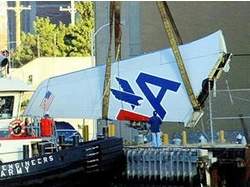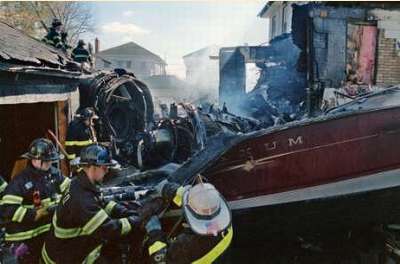Mon, May 31, 2004
Unrelated To AAL New York Crash, But Just As Deadly
It may not have been the fatal flaw in American Airlines Flight
587's 2001 crash, but it could be a big problem for future flights
of the Airbus A300-600.

According to the New York Times, the NTSB has turned up a flaw
in the rudder design of the A300. Investigators say the rudder of
the A300-600 can swing too far during rapid acceleration, causing
severe tail damage or even delamination of the aircraft. The NTSB
said the governor that limits the rudder's movements -- the
"limiter" -- didn't keep up with rapid changes in the speed of the
aircraft.
 Airbus apparently was ready for the
finding. Spokeswoman Mary Ann Greczyn said in a statement that a
complete redesign of the empennage was in order. "We expected it
was coming. It will add another level of safety for those
extraordinarily rare times when there are rapid changes in air
speed due to aircraft upset."
Airbus apparently was ready for the
finding. Spokeswoman Mary Ann Greczyn said in a statement that a
complete redesign of the empennage was in order. "We expected it
was coming. It will add another level of safety for those
extraordinarily rare times when there are rapid changes in air
speed due to aircraft upset."
At the focal point of the finding wasn't the November 12, 2001
crash of American Airlines Flight 587, but another incident
involving an American Airlines A300-600 in 1997. In that incident,
a flight crew member was injured when the aircraft, flying near
West Palm Beach (FL), dramatically increased velocity. The NTSB
said the limiter couldn't keep up with the rapid change in
airspeed. The aircraft subsequently lost about 3000 feet in
altitude as the crew struggled to regain control.
In its investigation of the 1997 incident, the NTSB said the
limiter system simply couldn't keep up with airspeed changes of
more than 2.4 knots/second. The A300-600 flying near West Palm
seven years ago was accelerating at approximately 10
knots/second.
American Airlines has been locked in a bitter battle with Airbus
over liability in the 2001 crash at Belle Harbor (NY). All 260
people on board Flight 587, as well as five people on the ground,
were killed after the copilot, apparently fighting severe wake
turbulence, swung the rudder drastically from side to side. As a
result, the NTSB says the vertical stabilizer departed the
aircraft, leading to the crash.

Now, American says it is already training its A300-600 pilots to
avoid "the specific shortcomings in the Airbus A300-600 rudder
control system that the NTSB recommendation involves."
More News
Aviation Governance Secured...At Least For a While The National Business Aviation Association similarly applauded the passage of the FAA's recent reauthorization, contentedly recou>[...]
Emphasis On Growing The Future of Aviation Through Concentration on 'AFFORDABLE FLYERS' It's been a number of years since the Latest Edition of Jim Campbell's HUGE SportPlane Resou>[...]
Amazilia Aerospace GmbH, Develops Digital Flight Control, Flight Guidance And Vehicle Management Systems Textron eAviation has acquired substantially all the assets of Amazilia Aer>[...]
Honeywell's Primus Brings New Tools and Niceties for Hawker Operators Hawker 4000 business jet operators have a new installation on the table, now that the FAA has granted an STC f>[...]
Company Celebrates Niche-but-Important Advancement in Industry Standards Echodyne has announced full integration of its proprietary 'EchoFlight' radar into the e American Aerospace>[...]
 Bolen Gives Congress a Rare Thumbs-Up
Bolen Gives Congress a Rare Thumbs-Up The SportPlane Resource Guide RETURNS!!!!
The SportPlane Resource Guide RETURNS!!!! Buying Sprees Continue: Textron eAviation Takes On Amazilia Aerospace
Buying Sprees Continue: Textron eAviation Takes On Amazilia Aerospace Hawker 4000 Bizjets Gain Nav System, Data Link STC
Hawker 4000 Bizjets Gain Nav System, Data Link STC Echodyne Gets BVLOS Waiver for AiRanger Aircraft
Echodyne Gets BVLOS Waiver for AiRanger Aircraft





